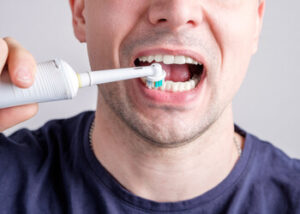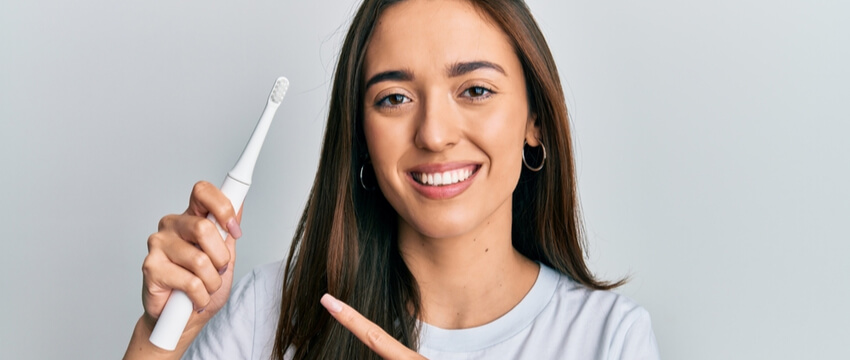Brushing your teeth twice a day gives you the best chance at fighting plaque and keeping your mouth free of bacteria. When you use an electric toothbrush, the toothbrush does most of the work for you and gives you peace of mind that you’re doing an effective job at keeping your mouth clean. We’ve put a step-by-step guide together on how to use an electric toothbrush to help you brush up on your technique.
The Importance Of Plaque Control
Your mouth is full of millions of bacteria that come together in a sticky film called plaque. At the end of a long day or after a night’s sleep, the surfaces of your mouth, including your teeth and tongue, are covered in this sticky film. The purpose of brushing with an electric toothbrush is to remove the plaque from the surface of each tooth and from your tongue. The purpose of flossing is to remove the plaque from in-between your teeth and below the gum line.
We can all only do as well as our brushing technique allows and for the majority of people this means that some plaque remains on the teeth and calcifies. When it calcifies, plaque turns into a hard substance called tartar. Only a dentist can remove hardened plaque using special dental instruments.
 When tartar is left on your teeth it becomes acidic and starts to erode your dental enamel. This is the beginning of active decay, which can turn into a cavity. Decay needs to be cleaned out by your dentist and cavities need to be filled with dental fillings to prevent you from losing your tooth completely. Tartar buildup can also lead to gum disease, which may result in tooth loss.
When tartar is left on your teeth it becomes acidic and starts to erode your dental enamel. This is the beginning of active decay, which can turn into a cavity. Decay needs to be cleaned out by your dentist and cavities need to be filled with dental fillings to prevent you from losing your tooth completely. Tartar buildup can also lead to gum disease, which may result in tooth loss.
Not only is plaque control important for the lifespan of your teeth and gums, but it has also been associated with a host of medical conditions such as atherosclerosis and problems with cardiovascular health.
Why Brushing Matters?
We all need to brush for at least two minutes, twice a day. And for those of us who use a manual toothbrush, this means holding the toothbrush at a 45-degree angle to the teeth and brushing in a circular motion.
When you use an electric toothbrush, the heads rotate and vibrate, essentially providing more action and power to remove plaque from the surfaces in the oral cavity. This means less effort is required by the user to do an effective job at cleaning the teeth.
How To Use An Electric Toothbrush: What To Watch Out For?
Using an electric toothbrush isn’t technically difficult, but it does require that you follow a cardinal rule: don’t press too hard or scrub your teeth. The reason for this is the fact that the heads are rotating already. The motion that they perform is optimal for plaque removal. Pushing too hard may affect your dental enamel or damage your gum tissue.
The key to using an electric toothbrush successfully is to consider yourself a guide and to guide the electric toothbrush over each tooth in your mouth. The good news is that many of the newer electric toothbrushes actually have pressure sensors that will alert you if you do press too hard.
How To Use An Electric Toothbrush: What To Do?
Electric toothbrushes need to be charged before they can be used. Most electric toothbrushes have an indicator that will let you know how much battery is available or if it needs recharging.
Start on one side of one jaw, and work your way methodically towards the other side. Electric toothbrushes just need to be held gently and guided onto each tooth to make the most of the oscillating heads. Make sure you clean by the gum line, and that you brush each surface of each tooth.
Once you have cleaned the outer surface of each tooth, start brushing the inner surface. Remember that it’s just as easy for food and debris to be trapped here too. Give special attention to the lower front teeth, and plaque is deposited most commonly on the lower teeth.
Electric toothbrushes also need to be used to clean the biting surfaces of your teeth, as well as your back teeth. The grooves of your back teeth can trap food and debris and are susceptible to decay too.
Electric toothbrushes can also be used to brush your tongue and the roof of your mouth. Your tongue and soft tissues can harbour lots of bacteria too and need to be cleaned as well as your teeth.
How To Use Electric Toothbrush: Utilise All The Features
Electric toothbrushes have some nifty features that make them extra useful, and which you may not even be aware of if you are still using a manual toothbrush.

Use the built-in timer
If you’re in a rush or distracted, brushing for two minutes might be easier said than done. Electric toothbrushes have built-in timers that ensure you do it right every time.
Make it fun for the kids
Dental hygiene can be boring and time-consuming for small children but there are plenty of electric toothbrushes that have lights, music and cute characters that keep young children engaged and entertained.
The Benefits Of An Electric Toothbrush
Suitable for patients with limited mobility
Electric toothbrushes make light work of dental hygiene for patients who have conditions that affect the mobility of the hands. They do not need to be manoeuvred around the mouth.
Gentler on teeth and gums
Electric toothbrushes with pressure sensors help you to be gentler on your gums and teeth.
Generate less waste
Electric toothbrushes do not need to be replaced in their entirety. When the bristles are worn down, you will only need to replace the head, as opposed to replacing a manual toothbrush every three to four months.
For help with how to use an electric toothbrush, please contact us: (02) 8806 3799










